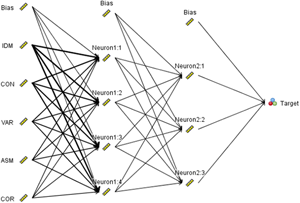Crossref Citations
This article has been cited by the following publications. This list is generated based on data provided by
Crossref.
Pantic, Igor V.
Shakeel, Adeeba
Petroianu, Georg A.
and
Corridon, Peter R.
2022.
Analysis of Vascular Architecture and Parenchymal Damage Generated by Reduced Blood Perfusion in Decellularized Porcine Kidneys Using a Gray Level Co-occurrence Matrix.
Frontiers in Cardiovascular Medicine,
Vol. 9,
Issue. ,
Qin, Li
Lai, Lin
Wang, Hongli
Zhang, Yukun
Qian, Xiaoyuan
and
He, Du
2022.
Machine Learning-Based Gray-Level Co-Occurrence Matrix (GLCM) Models for Predicting the Depth of Myometrial Invasion in Patients with Stage I Endometrial Cancer.
Cancer Management and Research,
Vol. Volume 14,
Issue. ,
p.
2143.
Pantic, Igor
Paunovic, Jovana
Pejic, Snezana
Drakulic, Dunja
Todorovic, Ana
Stankovic, Sanja
Vucevic, Danijela
Cumic, Jelena
and
Radosavljevic, Tatjana
2022.
Artificial intelligence approaches to the biochemistry of oxidative stress: Current state of the art.
Chemico-Biological Interactions,
Vol. 358,
Issue. ,
p.
109888.
Pantić, Igor
Paunović-Pantić, Jovana
and
Radojević-Škodrić, Sanja
2022.
Application of fractal and textural analysis in medical physiology, pathophysiology and pathology.
Medicinska istrazivanja,
Vol. 55,
Issue. 3,
p.
43.
Jordanova, Elena
Jankovic, Radmila
Naumovic, Radomir
Celic, Dejan
Ljubicic, Bojana
Simic-Ogrizovic, Sanja
and
Basta-Jovanovic, Gordana
2022.
The fractal and textural analysis of glomeruli in obese and non-obese patients.
Journal of Pathology Informatics,
Vol. 13,
Issue. ,
p.
100108.
Corridon, Peter R.
Wang, Xinyu
Shakeel, Adeeba
and
Chan, Vincent
2022.
Digital Technologies: Advancing Individualized Treatments through Gene and Cell Therapies, Pharmacogenetics, and Disease Detection and Diagnostics.
Biomedicines,
Vol. 10,
Issue. 10,
p.
2445.
Dey, Tapan
Dial, Asia
Corridon, Peter R.
and
Dutta, Saikat
2023.
Biosupercapacitors with minimized Self-Discharge.
Chemical Engineering Journal,
Vol. 470,
Issue. ,
p.
144101.
Pantic, Igor
Cumic, Jelena
Dugalic, Stefan
Petroianu, Georg A.
and
Corridon, Peter R.
2023.
Gray level co-occurrence matrix and wavelet analyses reveal discrete changes in proximal tubule cell nuclei after mild acute kidney injury.
Scientific Reports,
Vol. 13,
Issue. 1,
Corridon, Peter R.
2023.
Enhancing the expression of a key mitochondrial enzyme at the inception of ischemia-reperfusion injury can boost recovery and halt the progression of acute kidney injury.
Frontiers in Physiology,
Vol. 14,
Issue. ,
Pantic, Igor
Topalovic, Nikola
Corridon, Peter R.
and
Paunovic, Jovana
2023.
Oxidopamine-Induced Nuclear Alterations Quantified Using Advanced Fractal Analysis: Random Forest Machine Learning Approach.
Fractal and Fractional,
Vol. 7,
Issue. 10,
p.
771.
Chen, Shuwen
Wang, Jiaji
Ni, Yiyang
Shao, Jiaqi
Qu, Hui
and
Wang, Ziyi
2023.
Intelligent Data Engineering and Analytics.
Vol. 371,
Issue. ,
p.
131.
Valjarevic, Svetlana
Jovanovic, Milan B
Miladinovic, Nenad
Cumic, Jelena
Dugalic, Stefan
Corridon, Peter R
and
Pantic, Igor
2023.
Gray-Level Co-occurrence Matrix Analysis of Nuclear Textural Patterns in Laryngeal Squamous Cell Carcinoma: Focus on Artificial Intelligence Methods.
Microscopy and Microanalysis,
Vol. 29,
Issue. 3,
p.
1220.
Corridon, Peter R.
2023.
Still finding ways to augment the existing management of acute and chronic kidney diseases with targeted gene and cell therapies: Opportunities and hurdles.
Frontiers in Medicine,
Vol. 10,
Issue. ,
Pantic, Igor V.
Cumic, Jelena
Valjarevic, Svetlana
Shakeel, Adeeba
Wang, Xinyu
Vurivi, Hema
Daoud, Sayel
Chan, Vincent
Petroianu, Georg A.
Shibru, Meklit G.
Ali, Zehara M.
Nesic, Dejan
Salih, Ahmed E.
Butt, Haider
and
Corridon, Peter R.
2023.
Computational approaches for evaluating morphological changes in the corneal stroma associated with decellularization.
Frontiers in Bioengineering and Biotechnology,
Vol. 11,
Issue. ,
Pantic, Igor
Paunovic, Jovana
Cumic, Jelena
Valjarevic, Svetlana
Petroianu, Georg A.
and
Corridon, Peter R.
2023.
Artificial neural networks in contemporary toxicology research.
Chemico-Biological Interactions,
Vol. 369,
Issue. ,
p.
110269.
Wang, Xinyu
Elbahrawi, Rawdah Taha
Abdukadir, Azhar Mohamud
Ali, Zehara Mohammed
Chan, Vincent
and
Corridon, Peter R.
2023.
A proposed model of xeno-keratoplasty using 3D printing and decellularization.
Frontiers in Pharmacology,
Vol. 14,
Issue. ,
Wang, Xinyu
Shakeel, Adeeba
Salih, Ahmed E.
Vurivi, Hema
Daoud, Sayel
Desidery, Luca
Khan, Raheema L.
Shibru, Meklit G.
Ali, Zehara M.
Butt, Haider
Chan, Vincent
and
Corridon, Peter R.
2023.
A scalable corneal xenograft platform: simultaneous opportunities for tissue engineering and circular economic sustainability by repurposing slaughterhouse waste.
Frontiers in Bioengineering and Biotechnology,
Vol. 11,
Issue. ,
Sabha, Muath
and
Saffarini, Muhammed
2023.
Selecting optimal k for K-means in image segmentation using GLCM.
Multimedia Tools and Applications,
Vol. 83,
Issue. 18,
p.
55587.
Khan, Raheema L.
Khraibi, Ali A.
Dumée, Ludovic F.
and
Corridon, Peter R.
2023.
From waste to wealth: Repurposing slaughterhouse waste for xenotransplantation.
Frontiers in Bioengineering and Biotechnology,
Vol. 11,
Issue. ,
Corridon, Peter R.
2023.
Capturing effects of blood flow on the transplanted decellularized nephron with intravital microscopy.
Scientific Reports,
Vol. 13,
Issue. 1,




